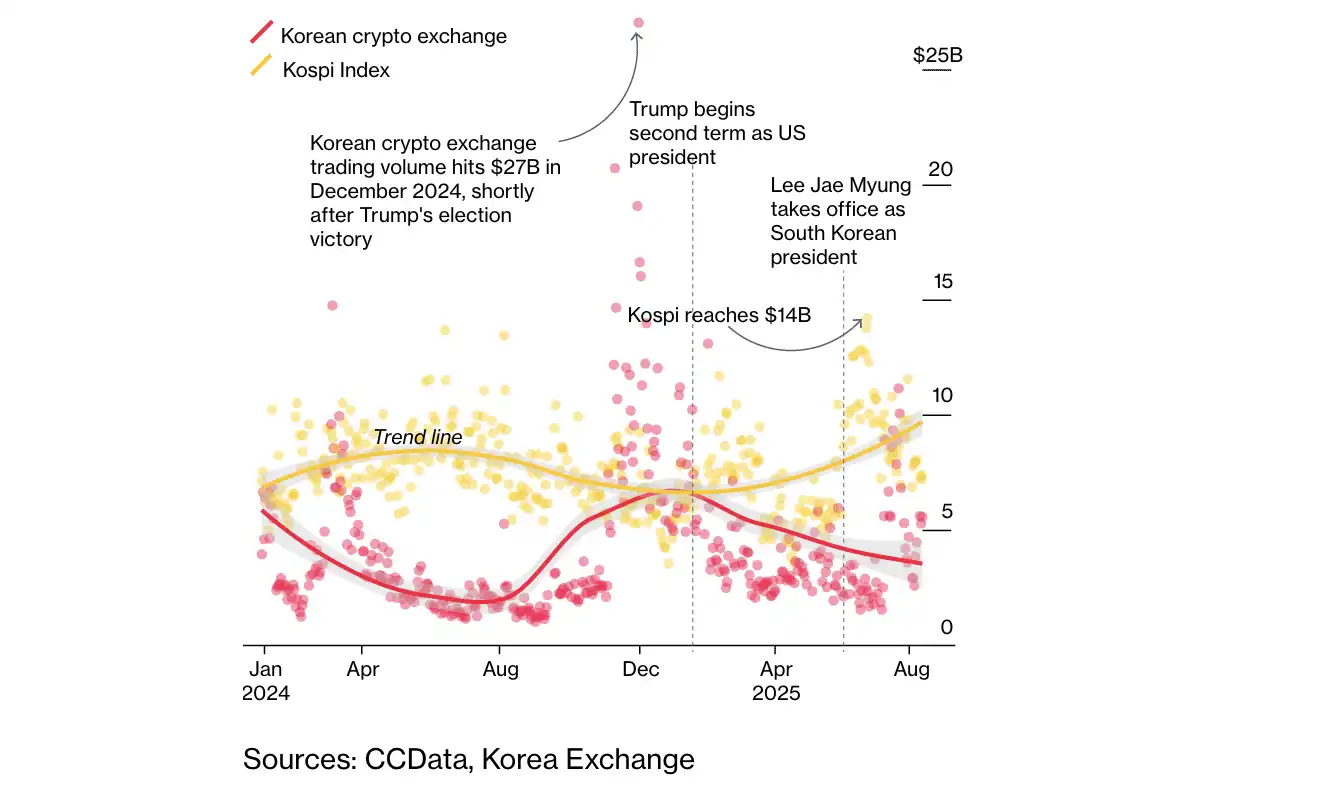The Lives of Korean Retail Investors: 14 Million "Ants" Flock to Cryptocurrency and Leverage
The article discusses the high-risk investment behavior of retail investors in South Korea, including going all-in on stocks, leveraged ETFs, and cryptocurrencies. It also examines the socio-economic pressures behind this behavior and its impact on individuals and the financial system. Summary generated by Mars AI This summary was produced by the Mars AI model, and the accuracy and completeness of its content are still being iteratively updated.
Translated by: Luffy, Foresight News
Tony Kim, a manager at a textile company in Seoul, goes all in on a single stock whenever he’s optimistic about it.
34-year-old Tony Kim has never held more than one stock at a time in his 140 million won (about $98,500) investment portfolio. The father of two said, “Koreans, myself included, are obsessed with that dopamine rush—it feels like it’s in our genes.”

Tony Kim
For many retail investors, this kind of operation might seem reckless or require extraordinary stress tolerance. But among the approximately 14 million retail investors in Korea, known as the “ant army,” this is just a snapshot of their extreme hunger for returns and ever-increasing risk appetite.
This desire is driving funds into investment accounts at near-record speeds. Over the past five years, Korean retail investors have doubled the scale of margin loans by leveraging up; they have poured into highly speculative leveraged and inverse exchange-traded funds (ETFs), accounting for 40% of the total assets of some leveraged ETFs registered in the United States. At the same time, trading volumes of high-risk cryptocurrencies have soared to all-time highs.
The frenzy of retail trading is not only reshaping the market but also making them an influential political force. The power and anxiety of these investors have become so strong that they have even forced the Korean government to reverse its policies for the first time.
Currently, global markets are being pushed to historic highs by the artificial intelligence infrastructure boom, but Korea’s highly leveraged retail investors are in an extremely vulnerable position. If market sentiment suddenly shifts, speculative positions could collapse instantly, and losses would be further amplified.
Such a reversal occurred just over a week ago. The escalation of the US-China tariff dispute triggered a cryptocurrency crash, with many altcoins instantly going to zero. Korean retail investors are known for their high-stakes bets on small-cap tokens. These tokens are highly volatile, accounting for over 80% of total trading volume on Korean cryptocurrency exchanges; in contrast, on global platforms, bitcoin and ethereum typically account for more than 50% of trading volume, forming a stark contrast.
For many Korean retail investors, all high-risk operations point to the same goal: accumulating enough wealth in a brutally competitive market to buy a home of their own. Koreans use the term “borrowed soul” to describe this struggle, a phrase that precisely reflects the emotional and economic pressure behind the dream of homeownership.
Recent government policies have further intensified retail investors’ risk-taking behavior. New President Lee Jae-myung’s implementation of mortgage limits and rental market reforms, which have led to rising rents, have made homeownership even more unattainable. Last week, the government introduced several measures to cool the overheated real estate market, including tightening loan limits in the greater Seoul area and lowering the loan-to-value ratio for mortgaged properties.
“Our parents’ generation accumulated wealth through the real estate boom of the Miracle on the Han River, but our generation hasn’t had such luck,” said 36-year-old Kim Soo-jin. She was once a business consultant and, after resigning, used her entire severance pay to start investing in cryptocurrencies. “In my circle, about 30 people have already ‘graduated’—meaning they’ve made enough money and exited high-risk investments.” She said, “I also hope to ‘graduate’ one day.”

The Han River in Seoul
Buyers Beware
The momentum of Korean retail investors chasing gains is evident across all markets. Since Donald Trump won the US election and began his second term last year, trading volumes on Korean domestic cryptocurrency exchanges have soared, at one point reaching 80% of the trading volume of Korea’s benchmark Kospi index; stablecoins pegged to fiat currencies have also attracted large amounts of retail funds.
Investors have also flocked to leveraged and inverse ETFs, products that use derivatives to amplify gains (and losses) by two to three times. Due to strict domestic regulations in Korea, such as simulated trading exercises and high margin requirements, retail investors have turned to overseas markets and have now become important participants in the global leveraged ETF market.

Comparison of trading volumes between Korean cryptocurrency exchanges and the Kospi index
The high-risk behavior of Korean retail investors not only puts household savings at risk but also puts pressure on the financial system, threatening overall economic stability. As investors flock to high-yield, high-risk assets, traditional financial instruments are falling out of favor, and banks’ channels for obtaining funds are being squeezed. In the six weeks after July this year, Korea’s major banks lost nearly 40 trillion won (about $2.81 billions) in deposits.
“In Korea, investing is often seen as gambling rather than long-term planning—almost as brutal as ‘Squid Game’,” said Choi Jae-won, an economics professor at Seoul National University. “Once the bubble bursts and individuals suffer a negative wealth shock, the problem worsens: personal credit crises emerge, consumption capacity declines, and ultimately the entire national economy is affected.”
Regulators are equally concerned. “We worry that if the market crashes, it will impact retail investors’ assets and the overall economy,” said Lee Yoon-soo, standing commissioner of the Korea Securities and Futures Commission.
Psychiatrists point out that high-risk investing is taking an increasing toll on individuals’ mental health. “Without inherited wealth, owning an apartment in Gangnam (Seoul’s wealthy district) is just a fantasy,” said Park Jong-sik. He once lost about $250,000 in investments and now runs a clinic specializing in treating investment addiction. “In this anxiety-filled society, even knowing the risks, people are still drawn to high-risk investments. It’s as if the whole system is pushing them forward, trapping them in an anxiety-driven cycle of investment addiction.”

Park Jong-sik
“Wiped Out Overnight”
For some, the scars of investment collapse are hard to heal. 35-year-old Han Jung-hoon once experienced the euphoria of his cryptocurrency wallet balance soaring 30-fold to 6.6 billion won, but the 2022 Luna crash wiped it all out.
TerraUSD was a stablecoin project launched by Korean Do Kwon, which ultimately ended in failure. In August this year, Do Kwon pleaded guilty to fraud, and the project’s collapse wiped out about $40 billions in market value within days.
“My 6.6 billion won profit disappeared overnight, and in the end, I got back less than 6 million won,” Han Jung-hoon said.
This crash completely changed his life. Although he hasn’t completely given up on cryptocurrencies, he has distanced himself from high-risk investments, focusing instead on meditation and even starting a YouTube channel to share his favorite breathing techniques. Now, he lives on the remote Jeju Island and occasionally travels to Bali for meditation retreats.

Han Jung-hoon
Even so, social media platforms like YouTube are still filled with stories of bold investment successes. Couples putting all their savings into bitcoin, 27-year-old college students earning tens of thousands of dollars a month through high-frequency trading... These stories are the bait that attract investors like Tony Kim.
Tony Kim currently holds all his positions in stocks such as Nvidia and Tesla. “I’ve made money using leverage, and that feeling of easy profit is addictive.” He recalled how he “made $900 to $13,000 overnight,” but lost all his gains in just three days. “You keep chasing that thrill of getting rich quick.”
Disclaimer: The content of this article solely reflects the author's opinion and does not represent the platform in any capacity. This article is not intended to serve as a reference for making investment decisions.
You may also like
The Base-Solana Bridge Dispute: "Vampire Attack" or Multichain Pragmatism?
The root of the contradiction lies in the fact that Base and Solana occupy completely different positions in the "liquidity hierarchy."

Stable TGE tonight: Is the market still buying into the stablecoin public chain narrative?
According to Polymarket data, there is an 85% probability that its FDV will exceed 2 billion USD on the day after its launch.

The Federal Reserve is likely to implement a hawkish rate cut this week, with internal "infighting" about to begin.
This week's Federal Reserve meeting may feature a controversial "hawkish rate cut." According to the former Vice Chair of the Federal Reserve, the upcoming 2026 economic outlook may be more worth watching than the rate cut itself.
Discover How ZKsync Fast-Tracks Blockchain Security
In Brief ZKsync Lite will be retired by 2026, having achieved its goals. ZKsync team plans a structured transition, ensuring asset security. Future focus shifts to ZK Stack and Prividium for broader application.

